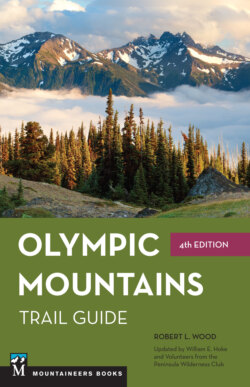Читать книгу Olympic Mountains Trail Guide - Robert Wood - Страница 43
На сайте Литреса книга снята с продажи.
8AURORA DIVIDE TRAIL
ОглавлениеLength: 5.4 mi/8.7 km
Access: Barnes Creek Trail; Aurora Ridge Trail; Happy Lake Ridge Trail
Custom Correct Map: Lake Crescent / Happy Lake Ridge, Washington
Green Trails Maps: Joyce, Wa. No. 102; Mt Olympus, Wa. No. 134
Agency: Olympic National Park
This trail connects a lowland path, the Barnes Creek Trail, with two upland ones, the Aurora Ridge Trail and the Happy Lake Ridge Trail. The path begins 4.0 mi/6.4 km up the Barnes Creek Trail from Lake Crescent, at 1500 ft/457 m elevation.
The route parallels an unnamed creek that flows in a deep ravine with the trail at first ascending through stands of Douglas-fir and western hemlock having little or no undergrowth. The forest is quiet, the silence broken now and then by the hoarse croaking of ravens. One can see, across the ravine to the left, where avalanches have knocked down a number of trees.
The climb is gradual, but steady, via long switchbacks, and as elevation is gained, Douglas-fir is replaced by silver fir. Near the ridge crest the terrain becomes less precipitous, and dense undergrowth is present.
As it switchbacks upward, the trail crosses an avalanche track several times. The slide zone is covered with thick growths of salmonberry, willow, huckleberry, devil’s club, and baneberry. The trail then climbs to a campsite (3.2 mi/5.0 km; 4200 ft/1280 m) where water is available.
The forest is thinner here, and huckleberry bushes grow beneath the trees. The path goes by two ponds, then meanders through moss-covered boulders and crosses the divide—Aurora Ridge or Happy Lake Ridge, whichever one chooses to call it. (This is near the indefinite point where one ridge becomes the other.) The trail then intersects the Aurora Ridge Trail (3.6 mi/5.8 km; 4750 ft/1448 m).
The trail climbs up and down as it follows Happy Lake Ridge, either traversing along the crest or on one side or the other. Here it alternates between forest and meadowland. The trees consist of subalpine fir, mountain hemlock, and silver fir; the wildflowers include lupines, gentians, mountain azalea, daisies, and thistles. Hikers should keep alert because the tread deteriorates and often disappears in the meadows. One should watch for signs of the trail or note on the tree trunks bits of orange-colored tape which indicate the way.
On this exposed divide, one can hear the wind in the trees—murmuring softly on quiet summer days, howling during wild autumn storms. At one point the trail dips a bit, and one can see, to the left, the steep pyramid of Lizard Head Peak (5370 ft/1637 m). The trail then enters a dense stand of subalpine fir. The tall trunks rise to a considerable height without limbs, and the crowns are festooned with lichens.
Eventually the trail comes out onto a slope where the sound of a stream—a tributary of the North Fork Sol Duc—rises faintly from below. The path continues down the ridge, and one can look to the right into the headwaters of the North Fork Sol Duc or to the left across the Barnes Creek watershed and the valley of Lizard Head Creek. During late September, Boletus edulis, the king bolete, a prized mushroom, can sometimes be gathered here.
Again the trail follows the narrow spine, at times through stands of subalpine fir and mountain hemlock, where gentians bloom beneath the contorted trees. Then, coming out into another meadow, the trail ends at a junction with the Happy Lake Ridge Trail (5.4 mi/8.7 km; 5020 ft/1530 m), where the latter departs its namesake ridge to follow an unnamed divide to Boulder Lake. This is not only confusing but also illogical, but the trails in the Olympics do not always follow a logical course.
